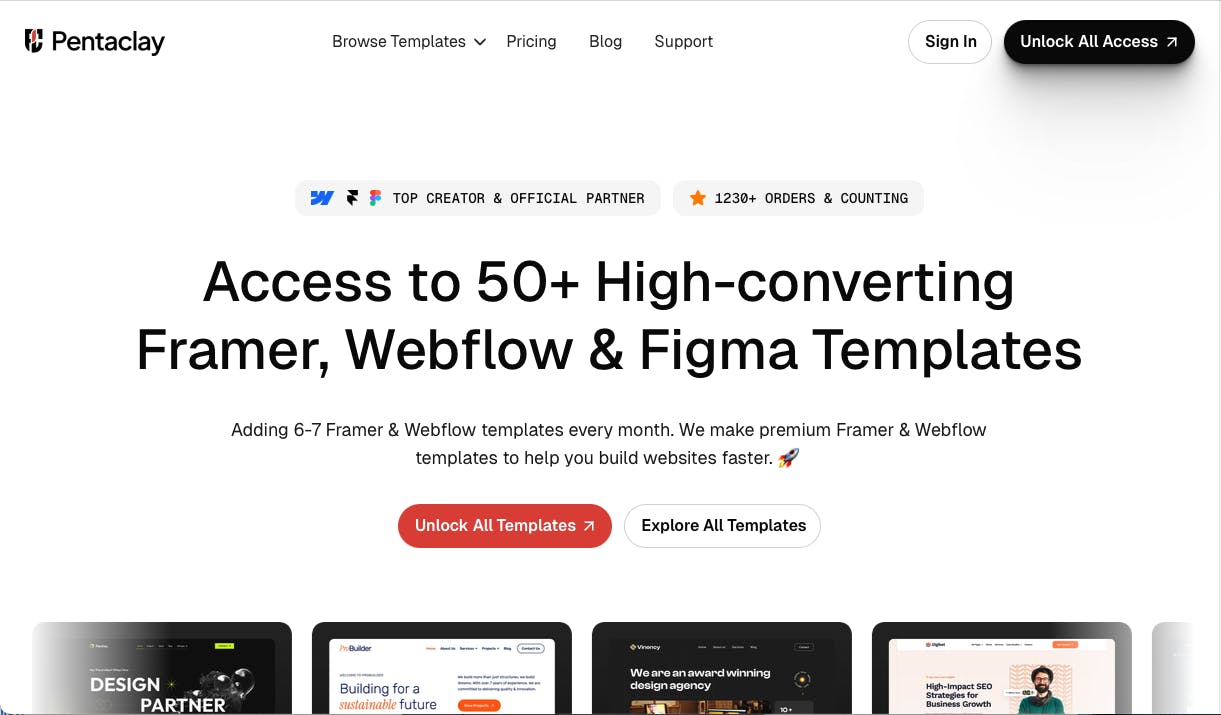From single experiment to portfolio of templates bringing in $9k/mo

Kazi Mohammed Erfan saw that design templates for Framer and Webflow were lacking real-world efficacy, so he learned the platforms and submitted his first template. Today, Pentaclay has 45+ templates bringing in $9k/mo, plus services bringing in another $6k/mo.
Here's Kazi on how he did it. 👇
From civil engineering to template design
I’ve always wanted to build something of my own — a brand where I could bring together great talent, apply everything I’ve learned from my client work, and create products that scale globally. That mix of creative freedom and real impact is what pushed me to start Pentaclay.
I graduated with a degree in Civil and Environmental Engineering, but during my studies in 2013, I became deeply drawn to design. What started as a side interest quickly became a genuine passion.
Since then, I’ve worked in the design field — collaborating with various clients and gaining experience through two on-site roles and three remote positions. Over the years, I’ve developed a strong understanding of both UI/UX design and product thinking, which helped shape my professional direction.
During that time, I noticed a real gap. Many templates in the market looked good but lacked usability, structure, and conversion focus. I wanted to change that by creating templates that not only look great but also perform well in real projects.
At Pentaclay we create premium Framer and Webflow templates and sell them either individually or through an All-Access pass giving users access to our full library. Alongside that, we also run a design and development agency under the same brand, working with clients to deliver high-quality, conversion-focused websites and digital products.
We’ve been consistently growing and have crossed $9k/mo in template sales, and if we include client projects, we’re now over $15k in monthly revenue.

Learning from scratch
When I started, there was a lot of hype around Framer on X, so I decided to give it a try. While exploring, I came across the Framer Template Marketplace, and that really caught my attention.
I started learning Framer from scratch and challenged myself to get one template approved in the marketplace — just to test my skills and understand the process. That first approval was a big motivation boost. One template quickly became two, two became ten, and now, combining Framer and Webflow, we’ve built over 45+ templates.
So the initial product really came from curiosity and experimentation, but as it gained traction, it evolved into a structured, research-driven process — focusing on design quality, performance, and niche relevance. That first step of challenging myself to build one template basically laid the foundation for everything we’re building today with Pentaclay.
Constant, interactive submissions
One of the biggest challenges I faced early on was figuring out how to scale template submissions effectively. After my first template, I paused to see how it would perform and, back then, I had to wait 14–15 days after submitting each template to see if it got approved. That slowed down learning and momentum quite a bit.
If I had to start over, I would focus on consistent, iterative submissions from the start. Today, we submit six templates per month on Webflow and seven or eight on Framer, which allows us to test, learn, and improve continuously. That approach has made a huge difference in speed, quality, and market understanding.
A design- and conversion-focused stack
For our templates and agency projects, we mainly work with Framer and Webflow as the core platforms. On the design side, I use Figma for UI/UX, prototyping, and collaborative design work.
For development and interactions, Framer covers most of our needs with its visual code capabilities. And Webflow handles CMS-driven and scalable websites. We also use analytics and tracking tools like Copilot and Google Analytics to monitor user behavior and optimize templates.
For project management and collaboration, we rely on Notion and Slack to keep the team aligned.
And we sell our templates with LemonSqueezy.
Finding niche opportunities
I identify niche opportunities through a combination of market research, competitor analysis, and real-world observation. For each niche, I study top-performing companies and websites, see what features and layouts they use, and identify gaps that aren’t addressed in existing templates.
We don’t just focus on high-demand niches — we also explore low-demand categories, which often have less competition but still real potential. This approach helps us create templates that are practical, relevant, and tailored to the needs of each niche.
Tracking users to improve quality
We track user behavior extensively — from traffic sources and heatmaps to sales performance, bounce rates, and conversion metrics. This data-driven process helps us understand what really works and continuously improve both our design and user experience.
For example, I initially assumed users didn’t really pay much attention to the FAQ section, so I just added a few basic ones based on competitors.
But when I started analyzing heatmaps and user behavior data, I was surprised to see that users were actually spending a significant amount of time on the FAQ section. That insight completely changed my perspective.
I realized that FAQs play a big role in building trust and improving conversions, especially for digital products. So, I revisited all the FAQs across our templates, rewrote them to address specific user concerns, and began tracking engagement regularly.
That small, data-driven change had a noticeable impact — users stayed longer, and our conversion rates improved as well.
Growth via strategic engagement
We’ve grown Pentaclay through a combination of product quality, niche research, and strategic outreach.
Every template is research-driven and high-quality, which naturally encourages users to trust our products and share them. Iterative feedback and analytics, mentioned earlier, play key roles in that.
We also focus on targeted visibility — sharing our work in design communities on X and Reddit, marketplaces like Framer and Webflow, and social platforms where creators and businesses look for templates. Engaging with these communities, providing helpful content, and showing real examples of how our templates perform has been a major factor in attracting users. Collaborating with other creators in these communities has helped too.
This engagement has led to direct inquiries from potential clients and collaborations, and some posts have reached 20,000–30,000 views, driving traffic to our templates.
Leaning on community
One thing I’ve found particularly helpful is the creator community itself. The Framer and Webflow communities are incredibly friendly and supportive — we share revenue insights, exchange ideas, and motivate each other.
Being part of this network has not only helped me learn faster but also stay inspired and make better decisions for Pentaclay.
Seeing how others solve design challenges keeps me motivated to push my own work further.
Growing the team
Until October, I was working solo, with the help of a few contractors. But last month, I began building a full-time team, and now we’re a team of eight talented people.
The focus right now is on laying strong foundations — building processes, improving product quality, and setting up a sustainable workflow. I believe once everyone’s operating at full potential, hitting $20k in revenue will be very achievable.
I’m aware the next couple of months might be a bit slower, but I see it as bending down before a big jump — we’re setting things up now to scale much faster in the coming quarters.
Start small and build in public
My advice for indie hackers would be to start small, iterate fast, and stay curious. Don’t wait for perfection — launch your first product or prototype, gather real user feedback, and improve continuously.
Focus on niche opportunities where you can stand out. For example, with Pentaclay, we started with SaaS templates to tap into the market, and then expanded into local services, portfolios, eCommerce, and more than ten other niches. Each niche allowed us to understand real user needs and create templates that solve specific problems.
Finally, build in public and engage with communities — sharing your process, challenges, and wins keeps you motivated and helps you connect with potential users or collaborators.
What's next?
My main goal for the future is to scale Pentaclay into one of the top digital design brands, recognized for both premium templates and high-quality client work. In the next 6–12 months, we’re focusing on expanding our template library, enhancing our All-Access offering, and reaching a consistent $30k+ monthly revenue.
We also plan to launch new products, plugins, and libraries over the coming months, targeting niches that complement our existing offerings. To achieve this, we’re building a full-time team, streamlining our production workflow, and using data-driven research to prioritize the most impactful products.
Long term, within the next 2–3 years, the goal is to grow Pentaclay into a full ecosystem for creators, offering templates, tools, and resources that help designers and businesses build and launch faster while maintaining top-tier design standards.
You can learn more about Pentaclay by visiting our website at pentaclay.com, where you can explore our premium Framer and Webflow templates, the All-Access pass, and our agency services. Or follow us on social platforms like X and Facebook, where we share updates, design insights, and tips for creators and businesses.

Leave a Comment
Thanks for covering my story.